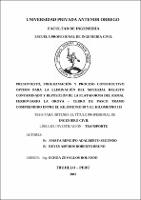Mostrar el registro sencillo del ítem
Presupuesto, programación y proceso constructivo optimo para la eliminación del material balasto contaminado y reposición de la plataforma del ramal ferroviario la oroya - cerro de pasco tramo comprendido entre el kilometro 50 y el kilometro 115
| dc.contributor.advisor | Ochoa Zevallos, Rolando | |
| dc.contributor.author | Amaya Rengifo, Adalberto Segundo | |
| dc.contributor.author | Reyes Aspiros, Roberto Bruno | |
| dc.creator | Amaya Rengifo, Adalberto Segundo | |
| dc.date.accessioned | 2019-10-21T21:00:04Z | |
| dc.date.available | 2019-10-21T21:00:04Z | |
| dc.date.issued | 2019 | |
| dc.identifier.uri | https://hdl.handle.net/20.500.12759/5554 | |
| dc.description.abstract | La Presente Tesis expone la situación actual de la vía férrea en el tramo La Oroya – Cerro de Pasco; en la cual se presencia restos de concentrados y el uso de material sulfuroso en el balasto y terraplén que generan aguas ácidas al entrar en contacto con el medio ambiente, considerándose este último el mayor problema ambiental encontrado en este tramo del Ferrocarril Central. Desde hace algunos años el ramal La Oroya – Cerro de Pasco del Ferrocarril Central, en la Reserva Nacional de Junín, se ha convertido en una preocupación para los pobladores aledaños a ésta, debido a la generación de drenajes ácidos originados por la oxidación del material sulfuroso contenido en varias secciones de la vía. Estos drenajes ácidos se acumulan a los lados de las vías, o discurren hacia los cursos de agua y sobre la superficie del terreno, especialmente en el periodo de lluvias. Para la eliminación del material contaminante en el ramal La Oroya – Cerro de Pasco y hacer la reposición de la misma se procedió a elaborar un Plan con el objetivo de proponer la alternativa más viable y sostenible; el cual contempla un procedimiento constructivo óptimo de las secciones afectadas en la vía férrea entre la progresiva 50+000 y la progresiva 115+000. El problema principal identificado, y que ha sido el motivo principal de la formulación del presente plan, es la presencia de drenajes ácidos en las áreas colindantes a la vía férrea en el ramal de La Oroya a Cerro de Pasco, entre el Km50 y el Km115. La causa del problema es el empleo de material sulfuroso en el balasto y terraplén de la vía férrea, en diferentes secciones a lo largo del tramo señalado, que al encontrarse expuesta a las condiciones atmosféricas se oxidan produciendo acidez y liberando sulfatos, hierro y otros elementos. Esta tesis no contempla la ingeniería de detalle de las estructuras de las estaciones ni de las obras de arte ya que no pretende demostrar el funcionamiento estructural de las mismas sino la viabilidad y costo aproximado de la Rehabilitación. | es_PE |
| dc.description.abstract | This Thesis exposes the current situation of the railway in the section La Oroya - Cerro de Pasco; in which remains of concentrates are present and the use of sulphurous material in the ballast and embankment that generate acidic waters when coming into contact with the environment, the latter being considered the greatest environmental problem encountered in this section of the Central Railroad. For some years now, the La Oroya - Cerro de Pasco branch of the Central Railroad, in the Junín National Reserve, has become a concern for residents near it, due to the generation of acid drains caused by the oxidation of sulfurous material. contained in several sections of the road. These acid drains accumulate on the sides of the tracks, or run towards the water courses and on the ground surface, especially in the rainy season. To eliminate the polluting material in the La Oroya - Cerro de Pasco branch and make the replacement of it, a Plan was developed with the objective of proposing the most viable and sustainable alternative; which contemplates an optimal constructive procedure of the affected sections on the railroad between the progressive 50 + 000 and the progressive 115 + 000. The main problem identified, and that has been the main reason for the formulation of this plan, is the presence of acid drains in the areas adjacent to the railroad in the branch of La Oroya to Cerro de Pasco, between Km50 and Km115 . The cause of the problem is the use of sulphurous material in the ballast and embankment of the railroad track, in different sections along the indicated section, which when exposed to atmospheric conditions oxidize producing acidity and releasing sulfates, iron and other elements . This thesis does not contemplate the detailed engineering of the structures of the stations or of the works of art since it is not intended to demonstrate the structural operation of them but rather the feasibility and approximate cost of the Rehabilitation. | en_US |
| dc.description.uri | Tesis | es_PE |
| dc.format | application/pdf | es_PE |
| dc.language.iso | spa | es_PE |
| dc.publisher | Universidad Privada Antenor Orrego - UPAO | es_PE |
| dc.relation.ispartofseries | T_ING.CIVIL_1777 | |
| dc.rights | info:eu-repo/semantics/openAccess | es_PE |
| dc.source | Universidad Privada Antenor Orrego | es_PE |
| dc.source | Repositorio institucional - UPAO | es_PE |
| dc.subject | Balasto | es_PE |
| dc.subject | Ferroviario | es_PE |
| dc.title | Presupuesto, programación y proceso constructivo optimo para la eliminación del material balasto contaminado y reposición de la plataforma del ramal ferroviario la oroya - cerro de pasco tramo comprendido entre el kilometro 50 y el kilometro 115 | es_PE |
| dc.type | info:eu-repo/semantics/bachelorThesis | es_PE |
| thesis.degree.level | Título Profesional | es_PE |
| thesis.degree.grantor | Universidad Privada Antenor Orrego. Facultad de Ingeniería | es_PE |
| thesis.degree.name | Ingeniero Civil | es_PE |
| thesis.degree.discipline | Ingeniería Civil | es_PE |
Ficheros en el ítem
Este ítem aparece en la(s) siguiente(s) colección(es)
-
Ingeniería Civil [1085]

